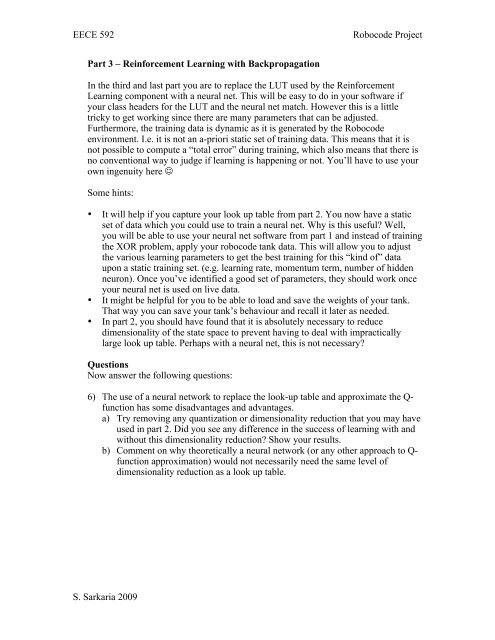EE592 Robocode Project 2009 - Courses
EE592 Robocode Project 2009 - Courses
EE592 Robocode Project 2009 - Courses
You also want an ePaper? Increase the reach of your titles
YUMPU automatically turns print PDFs into web optimized ePapers that Google loves.
EECE 592 <strong>Robocode</strong> <strong>Project</strong><br />
Part 3 – Reinforcement Learning with Backpropagation<br />
In the third and last part you are to replace the LUT used by the Reinforcement<br />
Learning component with a neural net. This will be easy to do in your software if<br />
your class headers for the LUT and the neural net match. However this is a little<br />
tricky to get working since there are many parameters that can be adjusted.<br />
Furthermore, the training data is dynamic as it is generated by the <strong>Robocode</strong><br />
environment. I.e. it is not an a-priori static set of training data. This means that it is<br />
not possible to compute a “total error” during training, which also means that there is<br />
no conventional way to judge if learning is happening or not. You’ll have to use your<br />
own ingenuity here <br />
Some hints:<br />
• It will help if you capture your look up table from part 2. You now have a static<br />
set of data which you could use to train a neural net. Why is this useful? Well,<br />
you will be able to use your neural net software from part 1 and instead of training<br />
the XOR problem, apply your robocode tank data. This will allow you to adjust<br />
the various learning parameters to get the best training for this “kind of” data<br />
upon a static training set. (e.g. learning rate, momentum term, number of hidden<br />
neuron). Once you’ve identified a good set of parameters, they should work once<br />
your neural net is used on live data.<br />
• It might be helpful for you to be able to load and save the weights of your tank.<br />
That way you can save your tank’s behaviour and recall it later as needed.<br />
• In part 2, you should have found that it is absolutely necessary to reduce<br />
dimensionality of the state space to prevent having to deal with impractically<br />
large look up table. Perhaps with a neural net, this is not necessary?<br />
Questions<br />
Now answer the following questions:<br />
6) The use of a neural network to replace the look-up table and approximate the Qfunction<br />
has some disadvantages and advantages.<br />
a) Try removing any quantization or dimensionality reduction that you may have<br />
used in part 2. Did you see any difference in the success of learning with and<br />
without this dimensionality reduction? Show your results.<br />
b) Comment on why theoretically a neural network (or any other approach to Qfunction<br />
approximation) would not necessarily need the same level of<br />
dimensionality reduction as a look up table.<br />
S. Sarkaria <strong>2009</strong>
















